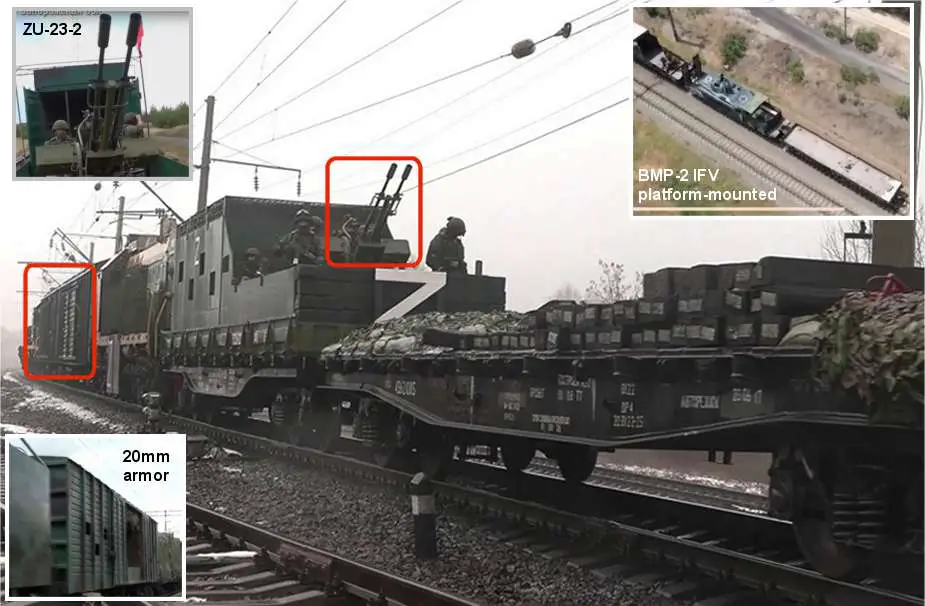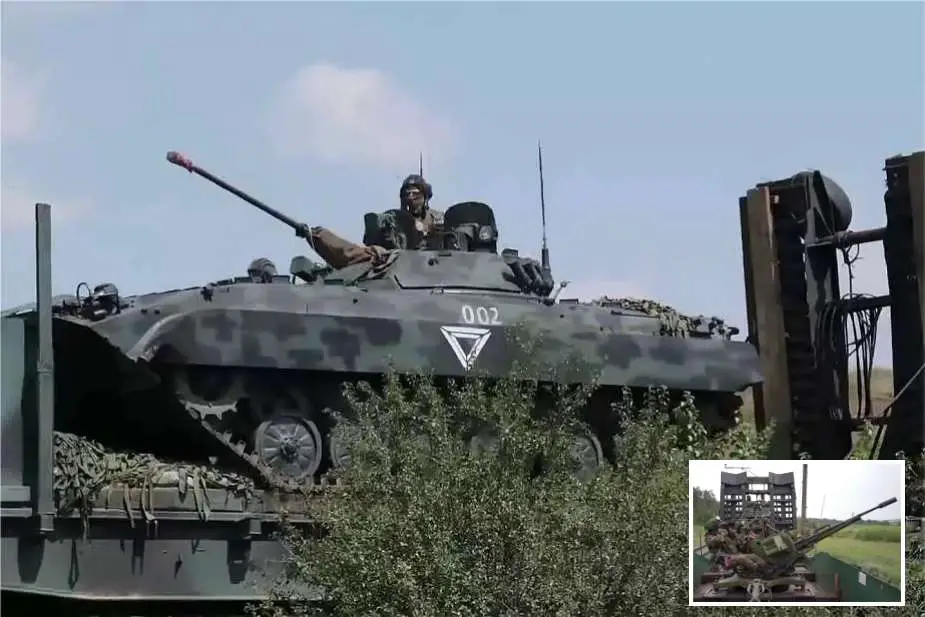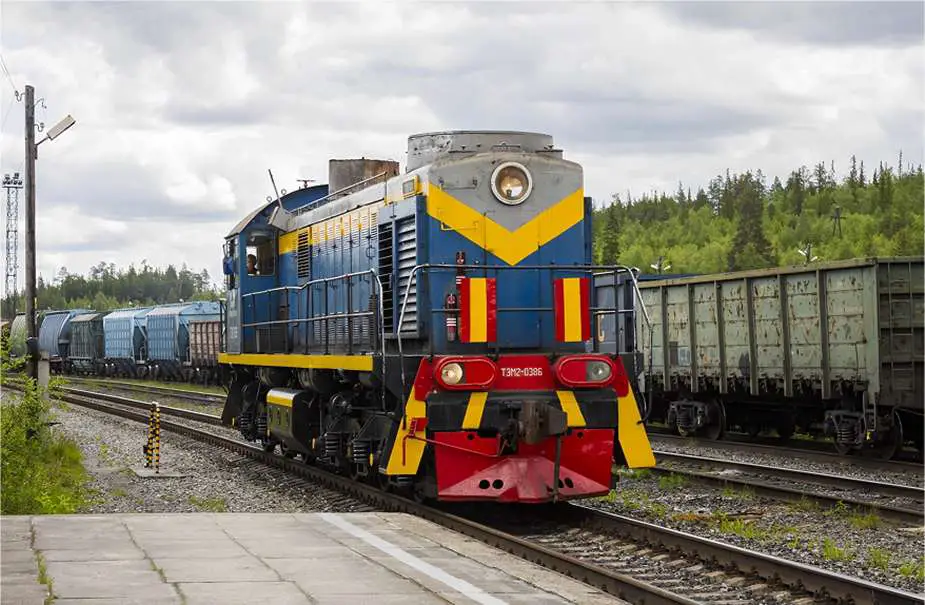On August 25, 2023, information emerged on Russian social media revealing the deployment of a second armored train designated as "Baikal," alongside the previously mentioned "Volga." These trains have been assigned roles in demining and escort operations within the Ukrainian combat zone. Notably, these trains are equipped with various weaponry, including a ZU-23-2 anti-aircraft gun system and a BMP-2 IFV (Infantry Fighting Vehicle) mounted on a flatbed railway car.
Follow Army Recognition on Google News at this link

Details within this video correspond with existing depictions of Russian armored trains, like the weaponry and armor characteristics (Picture source: Russian social media)
This development follows reports from August 8, 2023, when the Army Recognition editorial team initially disclosed the presence of an unnamed armored train in Ukraine, now identified as the Volga. The latest information on Russian social media confirms the presence of the second armored train named Baikal. According to the disclosure, the route and operational schedule of the Baikal armored train are established by officers from the General Staff of the Russian Federation's Armed Forces.
Specific roles and tasks of the Baikal armored train personnel
The train operates using a series of platforms, each serving a specific purpose. The initial platform, referred to as the "cover platform," precedes the main train, acting as a precautionary measure against potential contact with landmines. This proactive approach aims to ensure the safety of the train's movement.
The train's trained personnel have access to a diverse array of weaponry to guarantee the security of the Baikal train. Among the armaments at their disposal are a variety of equipment, including 23mm ZU-23-2 anti-aircraft guns, automatic grenade launchers (AGS-17), and machine guns. These resources are employed for engaging both targets in the air and those situated on the ground. In addition to its defensive capabilities, the train is equipped with weaponry designed to counter sabotage and reconnaissance activities. This includes anti-diversion and anti-reconnaissance measures, as well as anti-aircraft armaments for effectively responding to enemy attacks.
During the train's movement, the crew members inspect the railway tracks and the nearby terrain for any signs of explosive devices. Upon detecting such devices, a team of experienced sappers assesses the situation and determines whether to disarm the threat or conduct a controlled detonation.
Drone technology plays a crucial role in reconnaissance efforts. Drones are deployed ahead of the train's advancement, surveying the route and identifying potential obstacles or threats. This information helps ensure the safety of the train's journey.
Maintenance and repair are also integral components of the train's operations. The presence of spare parts and a specialized team ensures the ongoing functionality of the train. Moreover, locomotives located at both ends of the train facilitate controlled detonation in case of contact with explosive devices.
Coordination and communication are essential for the effective functioning of the train. Observers stationed at each end of the train guide the locomotive operators, ensuring smooth coordination and precise movements.
Finally, the core mission of the Baikal armored train personnel is to safeguard railway tracks, infrastructure, and repair teams from acts of sabotage. This includes track protection and the prevention of attacks on essential railway assets.
Historical Background
By the end of the 20th century, many global military forces had phased out armored trains, citing their outdated nature. In contrast, Russia continued to operate modified versions of these armored trains well into the twenty-first century. The last serial Soviet armored train, BP-1, designed to protect railway lines near the Soviet-Chinese border, was retired in the early 1990s and fell into disrepair. The Chechen campaigns prompted a reevaluation of the potential value of armored trains.
The renewed interest in armored trains stemmed from practical necessity. Supplying troops with ammunition, fuel, food, and other essentials relied heavily on efficient rail transport, particularly in challenging terrains and to counter sabotage risks by armed groups. The Federal Service of the Railway Troops, later succeeded by the Command of the Railway Troops of the Russian Federation, took on responsibilities such as restoring railway infrastructure, securing military transports, and providing protection.
In response, specialized armored trains were reintroduced. In 1994, a train equipped with platforms for repair work and defensive capabilities was introduced in Mozdok. This train featured BMP-2 armored vehicles armed with machine guns and grenade launchers for defensive purposes.
The significance of armored trains became more evident during the second Chechen campaign. With the expectation of attacks on rail routes due to the ongoing conflict, traditional patrolling proved inadequate. Armored trains proved to be strategically valuable in safeguarding railways. Specialized trains were used more extensively during the campaign. However, the railway infrastructure in Chechnya deteriorated, leading to its cessation of movement through the region as early as November 1994.
By 2002, special trains like "Amur," "Baikal," and "Terek" were established. In 2005, Major General V. Leshchishin reported the presence of four special trains within the United Group of Forces (OGV). The "Don" train was focused on construction tasks, while others were tasked with escorting trains through the hazardous Mozdok - Gudermes - Khankala section, conducting engineering reconnaissance, demining, and addressing sabotage aftermath.
These specialized trains were designed to fulfill specific roles. Despite facing attacks, their operational effectiveness remained largely intact. Debates arose about the continued relevance of armored trains, but their effectiveness in various conflict scenarios led to their retention within the Russian military. They have participated in exercises, protected railway bridges, and countered radio-controlled explosive devices.
In 2012, the Russian Minister of Defense acknowledged their value, particularly in local conflicts, leading to their continued use. In 2013, the armored trains were upgraded with the Kamysh system, providing protection against radio-controlled explosive devices within a 20-meter radius. In August 2016, "Amur" and "Baikal" participated in exercises focused on troop logistics.
Roles and tasks of Russian armored trains
Russian armored trains have been assigned a range of tasks. While many countries considered armored trains outdated by the end of the 20th century, Russia continued to utilize modified versions into the 21st century. The decline in railway protection along the Soviet-Chinese border resulted in the sidelining of the last serial Soviet armored trains, known as BP-1, in the early 1990s. However, the start of the Chechen campaigns renewed interest in the utility of armored trains.
Rail transport played a crucial role in supplying troops with necessities such as ammunition, fuel, food, and other critical supplies. The volume of these supplies necessitated rail transport, surpassing the capacities of road and air transport. To address this logistical challenge, the Federal Service of the Railway Troops was tasked with responsibilities including restoring and maintaining railway infrastructure in Chechnya, demining and guarding strategic railway sections, and securing the deployment areas of railway units.
However, these tasks were complicated by threats from illegal armed groups, which frequently targeted railways for sabotage and attacks. In response, Russia began employing specialized armored trains for challenging tasks related to maintaining smooth railway operations in conflict zones. These armored trains were equipped for various duties such as route reconnaissance, mine clearance, escorting military transports, and providing combat protection.
The introduction of these specialized armored trains occurred in December 1994 when General N. Koshman introduced the first of this kind. This train featured multiple platforms accommodating repair equipment and defensive armament, notably the BMP-2. These trains facilitated troop movement, infrastructure restoration, and communication line repair in conflict areas while dealing with hostile forces. Subsequent campaigns in Chechnya witnessed an increased deployment of these specialized trains due to the deteriorated railway infrastructure. This led to a wider utilization of armored trains. According to Colonel E. Fedorov, the onset of hostilities would likely lead to conflicts targeting highways, making traditional protective measures less effective. Drawing from historical examples of armored train effectiveness, the Russian military integrated them into their strategy. The use of armored trains Amur, Baikal, and Terek became vital for escorting military convoys through dangerous regions, engineering reconnaissance, demining operations, and countering sabotage.
These specialized trains varied in design and armaments but shared common elements. They included ballast platforms for protection against land mines, ZU-23-2 anti-aircraft platforms, BMP-2 or T-62 tank platforms, radio stations, locomotives, and more. The trains were equipped for both combat and crew rest and could be augmented with tanks and infantry fighting vehicles as needed.
While the Ministry of Defense initially considered phasing out these armored trains as part of reforms, their significance was recognized by Defense Minister S. Shoigu. These trains proved valuable in asymmetric warfare scenarios, including counterterrorism and ensuring railway safety. As a result, they were retained within the Russian Defense Ministry's arsenal.
In recent years, the restored armored trains Amur and Baikal participated in large-scale logistics exercises, demonstrating their continued utility. These exercises included bridge construction across water barriers, safeguarding restored bridges against mock enemy sabotage, and highlighting their role in modern warfare. Overall, Russian armored trains have showcased their adaptability, serving as a unique asset in protecting railway transport, supporting military operations, and addressing challenges in conflict zones.
Based on available information, it appears that Russia currently has five armored trains in service for various tasks and operations: Amur, Baikal, Don, Terek, and the previously undisclosed Volga train, as reported by the Army Recognition editorial team. Only the Baikal and Volga trains are confirmed to be operational in Ukraine, according to our information.
Composition of the Baikal armored train
The Baikal armored train serves specialized roles within the Russian armed forces, including combat protection, escort duties, and engineering reconnaissance. An analysis of the train's configuration, based on available information, reveals its essential components and functions.
To ensure comprehensive safety, the locomotive is centrally positioned, with the driver guided by an observer. The train's carriage walls are reinforced with 20-millimeter steel and supplemented by sandbags behind wooden panels. To counter mine explosions, the train incorporates platforms loaded with ballast materials like sand-filled bags, rails, and sleepers. These platforms act as a safeguard against mine effects. Additionally, a jamming platform equipped with the Kamysh system thwarts radio-controlled explosive devices within a 20-meter radius.
The train consists of several platforms, each equipped with tailored armaments to address various threats. At the heart of its structure is an armored box crafted from durable steel sheets. This enclosure serves as both a compartment for weaponry and the command center for operational activities. Firing apertures on the sides allow personnel to engage targets using their personal firearms from within the protected interior.
Two rotating turrets, mounted on the armored box, are armed with AGS-17 automatic grenade launchers featuring VOG-17 30mm ammunition and large-caliber machine guns. These turrets provide a firing arc of approximately 160 degrees, contributing to the train's defensive capabilities.

Russian armored trains are often armed with ZU-23-2 anti-aircraft gun systems and BMP-2 IFVs mounted on a platform wagon (Picture source Russian MoD)
Two platforms are notably fitted with ZU-23-2 anti-aircraft guns, bolstering the train's defenses against aerial threats. Other platforms showcase BMP-2 infantry fighting vehicles (potentially replaced by T-62 tanks) on flatbed railway cars, offering mobile firepower for engaging ground-based targets effectively.
The BMP-2 Infantry Fighting Vehicle (IFV) provides substantial firepower through its onboard weapons systems, including a stabilized 30 mm cannon 2A42 and a 7.62 mm PKT coaxial machine gun positioned to the left of the main armament, loaded with 2,000 rounds. Smoke grenade dischargers, arranged in banks of three, are situated on each side of the turret. Moreover, the BMP-2 can generate a smokescreen by introducing diesel fuel into the exhaust outlet on the right side of the hull. The turret roof houses an AT-4 Spigot or AT-5 Spandrel ATGMs launcher (Anti-Tank Guided Missiles) with a maximum range of 4,000 meters.
Enhancing the train's defenses are ZU-23-2 anti-aircraft autocannons, capable of engaging both aerial and ground threats due to their rapid cyclic rate of fire, which is approximately 2,000 rounds per minute.
Effective communication and coordination are facilitated by a platform housing a mobile radio station mounted on a ZIL-131 6x6 truck. This setup ensures seamless interaction among the crew and with other units. Logistic needs are met by a designated wagon named the "Kapterka," which transports essential supplies for maintenance, repairs, and operational continuity.
For crew comfort, one or two second-class passenger carriages provide relaxation spaces during operations. The movement of the train is powered by a TEM2 locomotive, designed to navigate railway tracks adeptly.
TEM2 locomotive
The TEM2 is a diesel locomotive with an electric transmission system, primarily designed for shunting operations within rail yards and confined areas. Manufactured between 1960 and 1974 at the Bryansk Engineering Plant and the Lugansk Diesel Locomotive Plant, a total of 4,355 TEM2 diesel locomotives were produced.
One notable characteristic of the TEM2 locomotive is its electric transmission system. This system involves the diesel engine generating electricity, which powers electric traction motors responsible for driving the locomotive's wheels. This design made the TEM2 particularly suitable for a precise movement of train cars in shunting tasks.
The TEM2 was developed as an improvement over its predecessor, the TEM1. It featured a hooded engine design and underwent several modifications over its production lifespan. Its power source was a PD1 diesel engine, developed based on the 2D50 diesel engine, with modifications aimed at enhancing performance and efficiency.
The locomotive's performance was also influenced by the models of traction electric motors used in different production runs of the TEM2. These variations contributed to the locomotive's operational improvements.
In terms of specifications, the TEM2 stands at a height of 5010 mm, measures 16,970 mm in length, and has a width of 3150 mm. It is adaptable to both 1435 mm and 1520 mm track gauges, with a designed maximum speed of 100 km/h. The locomotive's axial formula is 3 0 - 3 0, and it has a service weight of 120 tons. The transmission system is electric, utilizing direct current.
The evolution of the TEM2 led to various modifications and versions catering to different operational needs. Variants included TEM2A, TEM2AK, TEM2B, TEM2K, TEM2M, TEM2T, TEM2TN, TEM2U, and TEM2E, each offering specific improvements or adaptations for various circumstances.
The TEM2 found widespread use in different countries and regions, serving various roles in shunting and light freight transportation. It was employed in countries like Russia, Kazakhstan, Ukraine, Cuba, Bulgaria, Lithuania, Poland, Mongolia, Nigeria, and more. The TEM2 locomotive, along with its precursor, the TEM1, played a pivotal role in shunting operations within the domestic rail transportation sector. Over time, it was gradually replaced by newer models such as TEM3, TEM7, and TEM21.

The Baikal armored train is powered by a TEM2 locomotive (Picture source: Yandex)
















